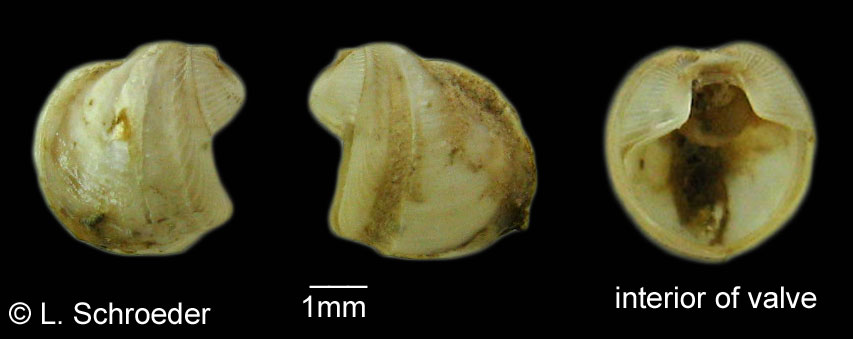Click on photo to enlarge. Scale line in photo equals 1cm unless otherwise specified.
* Species which are commonly encountered on the beach.
Bivalves
Family Pholadidae & Xylophagaidae
 Bamfield, BC
Bamfield, BC
Penitella conradi Valenciennes, 1846
Abalone Piddock
intertidal to 20m size to 35mm
northern Mexico to northern BC
This
shell is infrequently found. It bores into Abalone shells and
sometimes a few other thick-shelled species. This does not kill
the abalone.
 Campbell River, BC, found at very low tide in mudstone
Campbell River, BC, found at very low tide in mudstone
Xylophagaeidae
 off Point Chehalis, WA
off Point Chehalis, WA
Xylophaga washingtona Bartsch, 1921Washington Woodeater
subtidal, 75 to 2300m size to 6mm
southern California to northern Alaska
This
is rarely found intertidally, usually only when its habitat of
waterlogged wood and plant debris is washed ashore. Its small
size makes it difficult to see.

 both - Whiskey Creek Beach, WA
both - Whiskey Creek Beach, WA

 both - Pender Island, BC, intertidal
both - Pender Island, BC, intertidal
This page last revised: 6-29-2024
Penitella penita (Conrad, 1837)
Flat-Tip Piddock *
intertidal to 90m size to 95mm
northern Mexico to northern Alaska
This
is commonly found intertidally. It bores into clay, shale,
sandstone and even concrete. The shell narrows at the posterior
end and there is a flaring, almost rubbery tip extending from the
periostracum, the siphonoplax. It is the only one of our local
species which exhibits this. The siphon is smooth. The
shell is fragile and often breaks apart where
the sculpture changes pattern.
Penitella turnerae Evans & Fisher, 1966
Turner Piddock
intertidal to 5m size to 120mm
central California to northern BC
This
species is somewhat common intertidally, but is hard to find because
the shell bores into soft rock and hard clay. It is most often
confused with P. penita.
This shell does not have a siphonoplax. The siphon is smooth.


Pender Island, BC, intertidal
Rich Passage, WA, intertidal
Penitella richardsoni Kennedy, 1989Monterey Piddock
intertidal to 5m northern Mexico to southern BC size to 60mm
This
is somewhat common intertidally, but is hard to find because the shell
bores into soft rock. The siphon exhibits pustules which are
dense in the center of the siphon and become sparse near the tip.
The shell is very similar to our other piddocks although this
shell tapers more toward the siphon end.
(synonym - Penitella gabbii)
Zirfaea pilsbryi Lowe, 1931
Rough Piddock *
intertidal to 125m northern Mexico to northern Alaska size to 150mm
This
is more often found by sighting the siphons than finding the shells.
The siphons have a unique, irregularly-ridged siphon and
finger-like projections at the lip of the siphon opening. The
clams burrow into mud or clay as deep as two feet. The siphon can stretch quite
far, much like a geoduck. Occasionally some unusual three-holed
siphons have been sighted. The "twinned" siphon can be either the
inhalant or exhalant siphon. One was even found with both siphons twinned!






